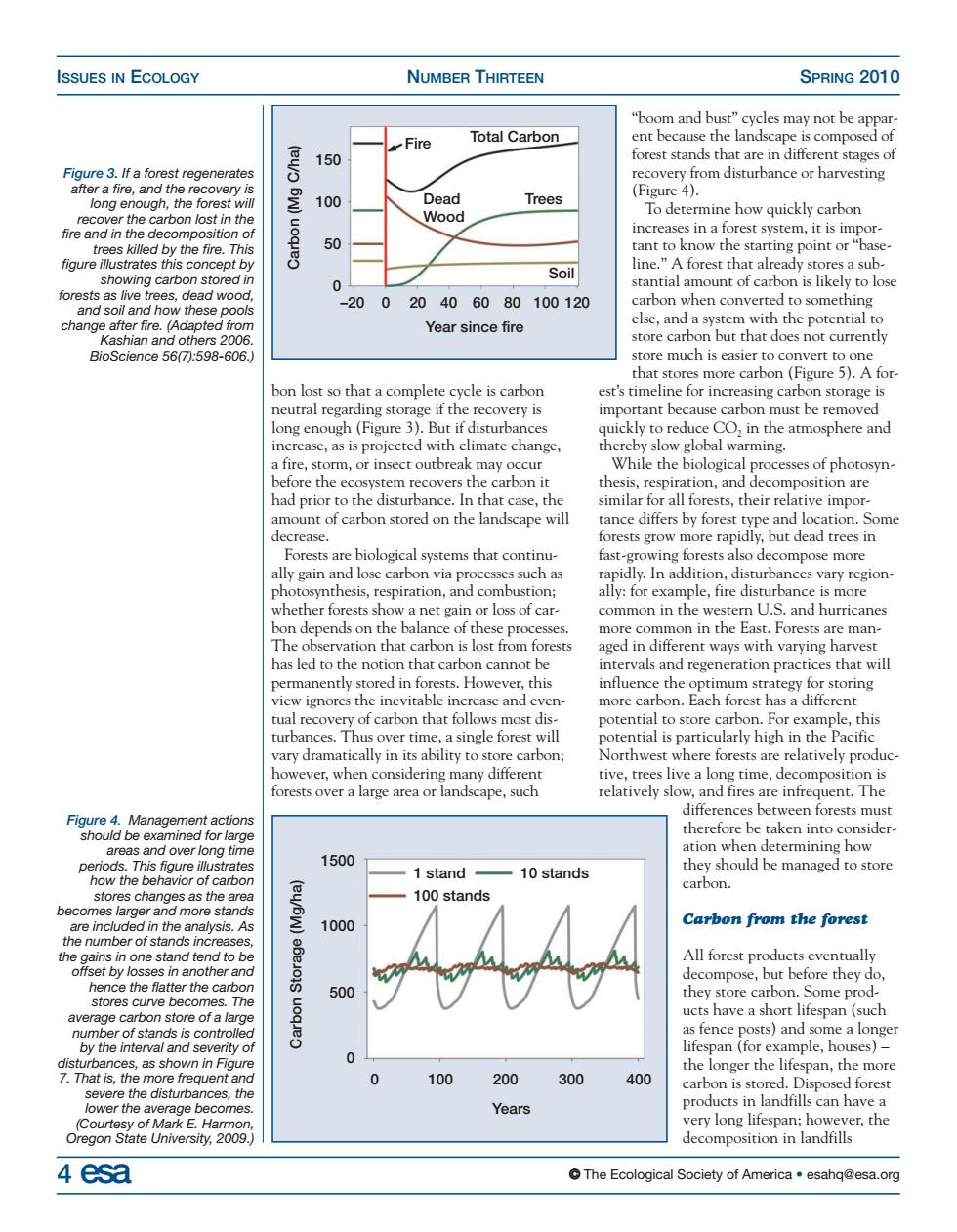正在加载图片...

ISSUES IN ECOLOGY NUMBER THIRTEEN SPRING 2010 .Fire Total Carbon Figure 3.If a fore 150 a fire and th y is Dead Trees Wood line."forest that already sto Soil s a sub stantial amount of car on is likely to lose -20020406080100120 after fire.(A Year since fire tore carb on but that does not currently BioScience56☑:598-606. bon lost so that a complete cvcle is carbon neutral regarding stor ge if the recovery is important because carbon must be removed quickly to in the atmosphere and or insect outbreak m of photosyn fore the he their re ve impor. orests are biological systems that continu yg照na lose cart bon via proces such a turbances vary region whether forests how a net gain or loss of car common in the wes tern U.S.and hurricanes bon depends on the balance of these processes sed that c nt ways arves rmanently stored in forests.However,this influence the gy for storing more carbon.Each forest has a differ ws most d vary dramatically in its ability to store carbon Northwest where forests are relatively produc cape,such re in therefore be taken into consider termining how pe 1500 -1 stand- -10 stands e managed to stor bec 1000 Carbon from the forest number of st All forest products eventually by but be the flatt 500 ore they do me pro e of a la as fence posts)and lifespan (for .That is,the span,t mor 100 200 300 00 ower th Years san have a Mark E.H very long lifespan;he 4 esa The Ecological Society of America esahq@esa.org ISSUES IN ECOLOGY NUMBER THIRTEEN SPRING 2010 bon lost so that a complete cycle is carbon neutral regarding storage if the recovery is long enough (Figure 3). But if disturbances increase, as is projected with climate change, a fire, storm, or insect outbreak may occur before the ecosystem recovers the carbon it had prior to the disturbance. In that case, the amount of carbon stored on the landscape will decrease. Forests are biological systems that continually gain and lose carbon via processes such as photosynthesis, respiration, and combustion; whether forests show a net gain or loss of carbon depends on the balance of these processes. The observation that carbon is lost from forests has led to the notion that carbon cannot be permanently stored in forests. However, this view ignores the inevitable increase and eventual recovery of carbon that follows most disturbances. Thus over time, a single forest will vary dramatically in its ability to store carbon; however, when considering many different forests over a large area or landscape, such “boom and bust” cycles may not be apparent because the landscape is composed of forest stands that are in different stages of recovery from disturbance or harvesting (Figure 4). To determine how quickly carbon increases in a forest system, it is important to know the starting point or “baseline.” A forest that already stores a substantial amount of carbon is likely to lose carbon when converted to something else, and a system with the potential to store carbon but that does not currently store much is easier to convert to one that stores more carbon (Figure 5). A forest’s timeline for increasing carbon storage is important because carbon must be removed quickly to reduce CO2 in the atmosphere and thereby slow global warming. While the biological processes of photosynthesis, respiration, and decomposition are similar for all forests, their relative importance differs by forest type and location. Some forests grow more rapidly, but dead trees in fast-growing forests also decompose more rapidly. In addition, disturbances vary regionally: for example, fire disturbance is more common in the western U.S. and hurricanes more common in the East. Forests are managed in different ways with varying harvest intervals and regeneration practices that will influence the optimum strategy for storing more carbon. Each forest has a different potential to store carbon. For example, this potential is particularly high in the Pacific Northwest where forests are relatively productive, trees live a long time, decomposition is relatively slow, and fires are infrequent. The differences between forests must therefore be taken into consideration when determining how they should be managed to store carbon. Carbon from the forest All forest products eventually decompose, but before they do, they store carbon. Some products have a short lifespan (such as fence posts) and some a longer lifespan (for example, houses) – the longer the lifespan, the more carbon is stored. Disposed forest products in landfills can have a very long lifespan; however, the decomposition in landfills Figure 3. If a forest regenerates after a fire, and the recovery is long enough, the forest will recover the carbon lost in the fire and in the decomposition of trees killed by the fire. This figure illustrates this concept by showing carbon stored in forests as live trees, dead wood, and soil and how these pools change after fire. (Adapted from Kashian and others 2006. BioScience 56(7):598-606.) Figure 4. Management actions should be examined for large areas and over long time periods. This figure illustrates how the behavior of carbon stores changes as the area becomes larger and more stands are included in the analysis. As the number of stands increases, the gains in one stand tend to be offset by losses in another and hence the flatter the carbon stores curve becomes. The average carbon store of a large number of stands is controlled by the interval and severity of disturbances, as shown in Figure 7. That is, the more frequent and severe the disturbances, the lower the average becomes. (Courtesy of Mark E. Harmon, Oregon State University, 2009.) Total Carbon Fire Dead Trees Wood Soil –20 0 20 40 60 80 100 120 Year since fire 150 100 50 0 Carbon (Mg C/ha) 1 stand 10 stands 100 stands 0 100 200 300 400 Years 1500 1000 500 0 Carbon Storage (Mg/ha) 4 esa © The Ecological Society of America • esahq@esa.org